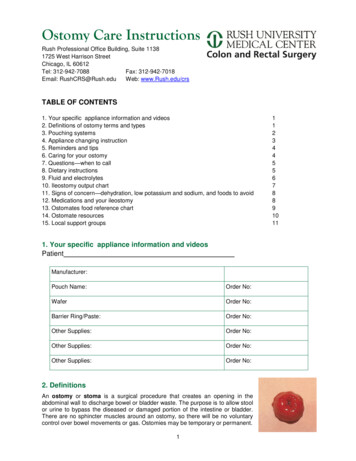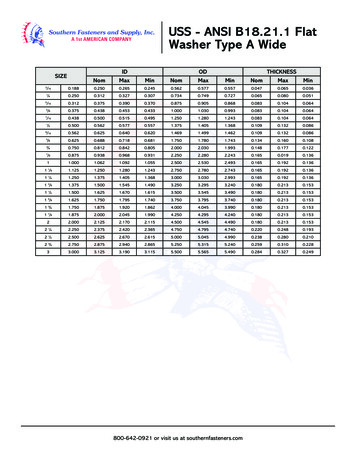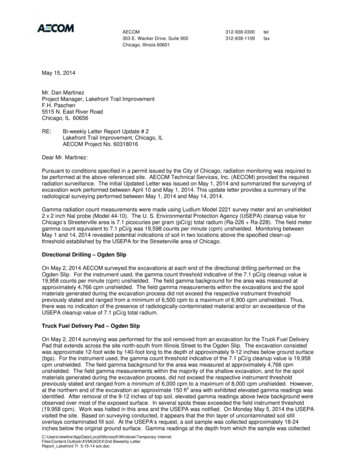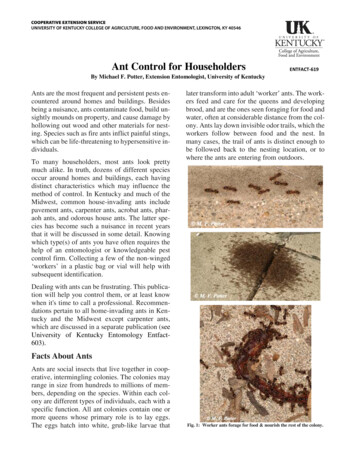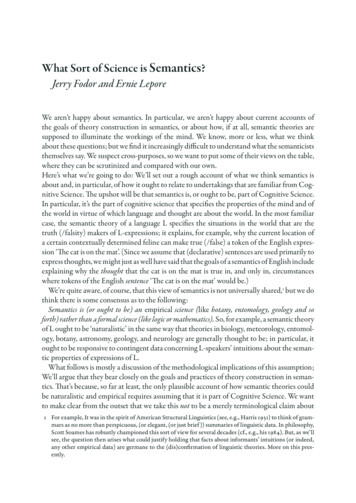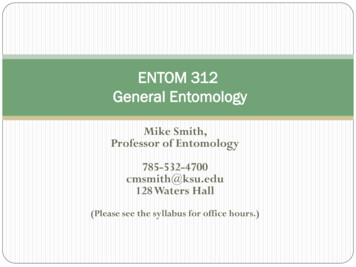
Transcription
ENTOM 312General EntomologyMike Smith,Professor of Entomology785-532-4700cmsmith@ksu.edu128 Waters Hall(Please see the syllabus for office hours.)
Why Should I Care About Insects ?Course ObjectivesStudents will be able to Explain the importance of insects Describe basic insect structure and function Describe the basic classification of economically important insects Explain how insects affect humans2General Entomology
Course OutcomesAt the end of the course, you should be able to Explain which order an insect belongs to Describe something about an insect’s structure and function Increase your insect appreciation and decrease yourentomophobia (ento - insect, phobia - fear) Not instinctively want to smash a bug!3General Entomology
Grading/Assessment Pop Tests (5 @ 10 points each) 50 points, keep best 4 (40 pts.)In-semester examinations* (3 @ 100 points each) - keep the best 2 scores (200 pts.) Comprehensive final (mandatory) (100 pts.) Group Report Presentations (60 pts.) Grade CompositionPop tests40 pts.Exams200 pts.Final100 pts.Group Reports 60 pts.Total Points 400 pts.Grading Scale:360 - 400 pts. - A320 - 359 pts. - B280 - 319 pts. - C240 - 279 pts. - D239 pts. & below - F*Exams (multiple choice, true/false fill-in-the-blank, & short essay questions - based on coherent,complete sentences!). No make-ups, except for true medical emergencies, as explained & verifiedby physician’s letter.4General Entomology
What Do You Doto Succeed in the Course ?1. Come to class. There will always be comments and discussion in class thatwill not be on the lecture files.2. Study the class notes before AND after each class. Don’t wait to “react” towhat’s presented. You’ll be behind from the start! Read about class lecture& discussion topics ahead of time. Do internet searches of informationrelated to lectures. Read the newspaper. Be ready to ask questions andcontribute to each class discussion.3. DO NOT WAIT UNTIL THE DAY BEFORE AN EXAM TO STUDY !!! 100 yearsof educational data prove this is a blueprint for failure. Read, re-read, andhighlite notes several times before each test.4. No question is unimportant. Most likely, for every one you think isunimportant, there are several people with the same curiosity.5. Read “entomocentrically”. Try to see the insect angle in news stories andscience news you read.5General Entomology
Why Study Insects? There are 10 quintillion(10,000,000,000,000,000,000)individual bugs on earth at anygiven moment !! Insects outnumber humans 200,000,000 to 1. lbs/acre (U.S.)Insects 400Humans 146General Entomology
Butterflies & Moths 160,000Ants & Bees - 100,000Flies - 90,000Beetles - 350,000WormsProtozaMammals- 6,000FishShellsSnails StarfishAll Other Insects - 100,000OtherArthropods1o 3,000 species 3/4 of all animals are Insects ( 750,000 species)7General Entomology
Why Classify Organisms? To study anything, we need a system of names - “nomenclature” Similarity is the basis for all nomenclature & morphological traitswere the first classifying traits. Carl Linneaus (b. 1707, Sweden), created a system of animal & plantclassification called binomial nomenclature: (bi two; nome names), i. e. the genus & the species The species is the basic unit of nomenclature; the genus includesseveral species. ex. Blatella germanica or Blatella germanica8General Entomology
Taxonomic Category Hierarchy Kingdom - Animalia Phylum Class - ArthropodaOrder FamilyGenusSpeciesKeep Putting Coffee On For Good Students9General Entomology
Phylum Arthropoda “jointed-feet”1. Bilateral symmetry2. An exoskeleton containing chitin3. Segmented body: 20-21 ring-like metameres4. Paired, jointed appendages5. Dorsal heart with open circulation & dorsal brain6.Ventral nerve cord & tracheal (air) system10General Entomology
hindgutMalphigiantubulesrectumair sacsDorsalmidgutcropheartostiaforegutnerve cordbrainocelluscompound heaemouthpartssalivary glandtibiatarsus11General Entomologyfemur
Arachnida(scorpions, ticks, spiders mites)cephalothorax & abdomen; no antennae;4 pairs of legs in adults; 1 pair mouthparts (chelicerae)Crustacea(barnacles, crabs, crayfish, lobsters, shrimp, pill bugs)2 pairs of antennae, 5 pairs of legs12General Entomology
Chilopoda (centipedes)wingless, multisegmented trunk, eachwith 1 pr. legs (except1st & last 2); 1 pr.antennae; firstsegment has poisonlegs (jaws) “toxicognaths”Diplopoda (millipedes)13GeneralJon EntomologyFouskariswingless; 1 pr. antennae;multi-segmented trunk,each with 2 pr. legs(except 1st 3); segmentsfused dorsally; many spp.secrete chemical defensethat may contain HCN
Negative Impacts–The Loss of Life, Food, and Homes 40% of all world food produced annually islost to insects Over 1 million people die each year ofmalaria, vectored by mosquitoesEarly bioterrorism/biowarfare - 1346,Tartar army hurled corpses of victims offlea-vectored plague over the walls of Kaffain southern Russia.14General Entomology
Positive Impacts - Food, Clothing, Medicine Allantoin, secreted by maggots, discovered to heal Raw silk Silk mothdeep wounds in World War I 1/3 of the human diet is the direct result of insectpollinationSilk production in Asia & EuropeScale insects used to make red dyes to colorcosmetics, foods, & medicine.Soil fertility from decomposers & burrowers; control ofpests by predators and parasites (good bugs) -- 20BILLION per yr. ( ) to U.S. economyEgg mass Insects invading corpses arestandard forensic tools used to makeaccurate estimates of the time andcause of death!15General Entomology
Summary More insects than ALL other animals 16combinedCrops: the good and the badVectors of many diseases BUT provide useful productsCrime solving abilityModel organisms for researchWithout insects, life as we know it would not be possible.General Entomology
Many insect are so light thatgravity has no effect onthem. They run up verticalsurfaces & if they lose theirgrip & fall, they are rarelyinjured when they hit theground.“Bugs are not going toinherit the earth. They ownit now.So we might as well makepeace with the landlord”Thomas Eisner17General Entomology
Conclusion Some of the imagery has been provided through Wiley-Blackwell with their permission. All course contents arecopyrighted and should not be used for non-course-learningpurposes.18General Entomology
Grading/Assessment 4 General Entomology Pop Tests (5 @ 10 points each) 50 points, keep best 4 (40 pts.) In-semester examinations* (3 @ 100 points each) - keep the best 2 scores (200 pts.) Comprehensive final (mandatory) (100 pts.) Group Report Presentations (60 pts.) Grade Co

